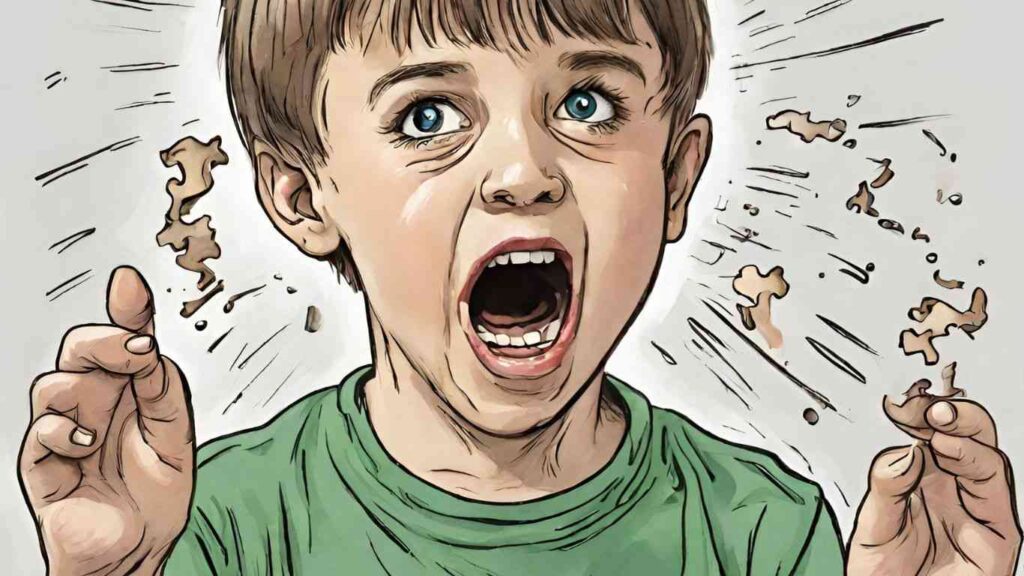Autism spitting behavior is a common challenge among individuals with autism spectrum disorder (ASD). This behavior can be distressing for parents, caregivers, and teachers, and can also be a source of embarrassment for the individual with ASD. Understanding the reasons behind this behavior can help caregivers and educators develop effective strategies to manage it.
Spitting behavior can be a form of sensory seeking or sensory avoidance. Some individuals with ASD may engage in spitting as a way to seek sensory input, while others may use it as a way to avoid certain sensory experiences. For example, an individual may spit when they encounter a taste or texture that they find unpleasant. Alternatively, they may spit when they are overstimulated and need to release energy.
It is important to note that spitting behavior is not necessarily intentional or malicious. Individuals with ASD may not be aware of the social implications of spitting or may struggle to control their impulses. Caregivers and educators should approach this behavior with patience and understanding, rather than punishment or shame.
There are several strategies that can be used to manage spitting behavior. These include:
- Identifying triggers: Caregivers and educators should work to identify the specific situations or stimuli that trigger spitting behavior. This can help them develop strategies to avoid or manage these triggers.
- Providing alternative sensory experiences: Providing alternative sensory experiences, such as chew toys or fidget toys, can help individuals with ASD meet their sensory needs without resorting to spitting.
- Teaching replacement behaviors: Caregivers and educators can work with the individual with ASD to identify replacement behaviors that are more socially acceptable than spitting. These might include deep breathing, taking a break, or using a specific word or phrase to communicate discomfort.
By Knowing the reasons behind spitting behavior and developing effective strategies to manage it, caregivers and educators can help individuals with ASD lead more fulfilling and socially connected lives.
Causes of Spitting Behavior in Autism
Individuals with Autism Spectrum Disorder (ASD) may exhibit spitting behavior, which can be concerning for caregivers and family members. While the exact causes of spitting in autism are not fully understood, there are several factors that may contribute to this behavior.
One potential cause of spitting behavior in autism is sensory processing difficulties. People with ASD may experience sensory overload or under-stimulation, leading to self-stimulatory behaviors such as spitting. Additionally, some individuals with autism may use spitting as a way to regulate their sensory input or to cope with overwhelming situations.
Another possible cause of spitting behavior in autism is communication difficulties. People with ASD may struggle to express themselves verbally, leading to frustration and a need for alternative forms of communication. Spitting may be a way for individuals with autism to communicate their needs or to express their emotions.
Medical issues may also contribute to spitting behavior in autism. Some individuals with ASD may have gastrointestinal issues, such as acid reflux or constipation, which can cause discomfort and lead to spitting. Additionally, certain medications used to treat autism-related symptoms may have side effects that include spitting.
It is important to note that spitting behavior in autism is not intentional or malicious. Rather, it is a symptom of underlying issues that require understanding and support from caregivers and healthcare professionals. By identifying the causes of spitting behavior in autism, interventions can be put in place to help individuals with ASD manage their symptoms and improve their quality of life.
Read also: Early Intervention for Children with Developmental Challenges
Impacts of Spitting Behavior
Individuals with autism may display spitting behavior, which can have various impacts on their daily lives and those around them. Spitting behavior can be a challenging behavior to manage, and it can lead to negative consequences for the individual and others. In this section, we will discuss some of the impacts of spitting behavior in individuals with autism.
1. Physical Impacts
Spitting behavior can have physical impacts on the individual with autism. For instance, spitting can lead to oral health issues such as tooth decay and gum disease. It can also lead to infections if the individual spits on an open wound. Furthermore, spitting can cause the individual to choke if they accidentally inhale the saliva or if the saliva enters their airway.
2. Social Impacts
Spitting behavior can also have social impacts on the individual with autism. Spitting can be perceived as socially inappropriate and can lead to social isolation and rejection. It can also lead to negative reactions from others, which can further reinforce the behavior. Additionally, spitting can be disruptive to others, especially in public settings, and can lead to negative interactions with peers, caregivers, and strangers.
3. Emotional Impacts
Spitting behavior can also have emotional impacts on the individual with autism. Spitting can be a form of self-stimulation or self-regulation, and the individual may feel distressed or anxious if they are prevented from engaging in the behavior. Furthermore, the individual may feel embarrassed or ashamed if they are scolded or punished for the behavior, which can lead to low self-esteem and self-worth.
Overall, spitting behavior in individuals with autism can have various impacts on their daily lives and those around them. It is important to understand the underlying reasons for the behavior and to develop appropriate strategies to manage it effectively.
Read also: Effective Strategies to Help Your Child Cope with Anxiety
Assessing Spitting Behavior in Autism
Assessing spitting behavior in autism can be challenging, as it can be a complex and multifaceted behavior. However, there are a number of ways that can be considered when assessing this behavior, including:
1. Physical Assessment
When assessing spitting behavior in individuals with autism, physical assessment is necessary to rule out any underlying medical conditions that may be contributing to the behavior. Medical conditions such as gastroesophageal reflux disease (GERD), dental issues, or oral motor difficulties can cause discomfort, pain, or sensory issues that lead to spitting behavior.
A physical assessment may include a thorough examination of the individual’s oral cavity, including the teeth, gums, and tongue, as well as an evaluation of their swallowing and oral motor skills. A speech and language pathologist or occupational therapist may be consulted to assess any oral motor difficulties and provide appropriate interventions.
2. Behavioral Assessment
In addition to a physical assessment, a behavioral assessment is also necessary to understand the function of the spitting behavior. A functional behavior assessment (FBA) can help identify the antecedents, behavior, and consequences of the spitting behavior to determine the function it serves for the individual.
During the FBA, the individual’s environment, daily routines, and social interactions are observed to determine what triggers the spitting behavior and what reinforces it. This information is used to develop a behavior intervention plan (BIP) that addresses the underlying function of the behavior and provides alternative, more appropriate behaviors to replace the spitting behavior.
It is important to note that spitting behavior may serve different functions for different individuals with autism. For some, it may be a means of communication or a way to regulate sensory input, while for others, it may be a form of self-stimulation or a response to anxiety or frustration. Therefore, a personalized approach to assessment and intervention is necessary to effectively address spitting behavior in individuals with autism.
Interventions for Autism Spitting Behavior
There are a number of interventions that can be used to manage and reduce spitting behavior, but it is important to choose the right approach for the individual.
1. Behavioral Interventions
Behavioral interventions are the most common approach to addressing autism spitting behavior. These interventions aim to teach individuals with autism alternative ways to communicate their needs and wants, as well as to manage their emotions and behaviors.
One behavioral intervention that has been successful in reducing spitting behavior is Applied Behavior Analysis (ABA). ABA involves breaking down complex behaviors into smaller, more manageable steps and teaching individuals how to perform these steps. This approach can be used to teach individuals with autism how to communicate their needs and wants using alternative methods, such as sign language or picture communication systems.
Another effective behavioral intervention is Positive Behavior Support (PBS). PBS involves identifying the triggers for spitting behavior and developing strategies to prevent these triggers from occurring. For example, if an individual with autism spits when they are overwhelmed, a PBS plan might involve teaching the individual relaxation techniques or providing a quiet space where they can go to calm down.
2. Medical Interventions
In some cases, medical interventions may be necessary to address spitting behavior in individuals with autism. These interventions may include medication or medical procedures.
One medication that has been used to reduce spitting behavior in individuals with autism is risperidone. Risperidone is an antipsychotic medication that can help to reduce aggression and self-injurious behavior in individuals with autism. However, it should be noted that this medication can have side effects, such as weight gain and sedation.
In rare cases, medical procedures may be necessary to address spitting behavior. For example, if an individual with autism is spitting due to an underlying medical condition, such as acid reflux, treating the underlying condition may help to reduce spitting behavior. However, medical interventions should only be considered after other interventions have been tried and deemed ineffective.
Preventing Autism Spitting Behavior
Preventing spitting behavior in individuals with autism can be challenging, but it is possible with the right strategies and support. Here are some tips and techniques that can help prevent autism spitting behavior:
1. Identify Triggers
The first step in preventing spitting behavior is to identify the triggers that cause it. This could be anything from anxiety or frustration to sensory overload or boredom. Once the triggers are identified, steps can be taken to reduce or eliminate them.
2. Provide Sensory Support
Many individuals with autism engage in spitting behavior as a way to self-regulate or seek sensory input. Providing appropriate sensory support, such as chew toys or weighted blankets, can help reduce the need for spitting.
3. Teach Alternative Behaviors
Teaching alternative behaviors to replace spitting can be an effective way to prevent the behavior. This could include teaching the individual to take deep breaths or engage in another calming activity when feeling anxious or frustrated.
4. Use Positive Reinforcement
Positive reinforcement can be a powerful tool in preventing spitting behavior. Praising and rewarding the individual when they engage in appropriate behavior can increase the likelihood that they will continue to do so.
5. Seek Professional Support
If spitting behavior persists despite efforts to prevent it, it may be helpful to seek professional support from a behavior therapist or other qualified healthcare professional. They can provide additional strategies and support to help prevent the behavior.
Read also: Supporting Student Growth In Special Needs Classes
Case Studies on Autism Spitting Behavior
Studies have shown that spitting behavior is a common occurrence in individuals with autism. In this section, we will examine a few case studies that highlight the prevalence and impact of spitting behavior in individuals with autism.
Case Study 1
A 10-year-old boy with autism was observed to spit frequently during therapy sessions. The behavior was found to be triggered by stress and anxiety. The boy’s therapist implemented a behavior modification plan that included positive reinforcement for appropriate behavior and redirection when spitting behavior occurred. Over time, the frequency of spitting behavior decreased, and the boy was able to engage in therapy sessions without interruption.
Case Study 2
A 16-year-old girl with autism was observed to spit frequently in public places. The behavior was found to be triggered by sensory overload and frustration. Her parents worked with her therapist to develop a sensory diet that included activities to help regulate her sensory input. Additionally, the girl was provided with a communication device to help her express her needs and frustrations. These interventions helped to reduce the frequency of spitting behavior in public places.
Case Study 3
A 7-year-old boy with autism was observed to spit frequently during meal times. The behavior was found to be triggered by a dislike of certain textures and flavors of food. His parents worked with a speech therapist to develop a feeding plan that included exposure to a variety of textures and flavors of food. Additionally, the boy was provided with a visual schedule to help him understand the mealtime routine. These interventions helped to reduce the frequency of spitting behavior during meal times.
These case studies demonstrate the importance of identifying the triggers of spitting behavior in individuals with autism and implementing appropriate interventions to reduce the frequency of the behavior.
Resources for Parents and Caregivers
Parents and caregivers of children with autism who engage in spitting behavior may find it challenging to manage and cope with this issue. However, there are several resources available to help them understand and address this behavior. Here are some resources that may be helpful:
1. Autism Speaks
Autism Speaks is a non-profit organization that provides information, resources, and support for individuals with autism and their families. Their website offers a comprehensive guide on challenging behaviors, including spitting. The guide provides information on why spitting may occur, strategies for preventing and managing it, and resources for further support.
2. National Autism Association
The National Autism Association is a non-profit organization that provides advocacy, education, and support for families affected by autism. Their website offers a variety of resources, including a section on challenging behaviors. The section provides information on the causes of spitting behavior, tips for managing it, and links to additional resources.
3. Autism Society
The Autism Society is a non-profit organization that provides support and resources for individuals with autism and their families. Their website offers a variety of resources, including a section on behavior management. The section provides information on how to address challenging behaviors, including spitting, and offers tips and strategies for managing them.
4. Behavior Analyst Certification Board
The Behavior Analyst Certification Board (BACB) is a non-profit organization that provides certification for behavior analysts. Their website offers a directory of certified behavior analysts who can provide support and guidance for families dealing with challenging behaviors, including spitting.
In conclusion, parents and caregivers of children with autism who engage in spitting behavior can benefit from the resources offered by organizations such as Autism Speaks, the National Autism Association, the Autism Society, and the Behavior Analyst Certification Board. These resources can provide helpful information, strategies, and support to manage and cope with this behavior.







